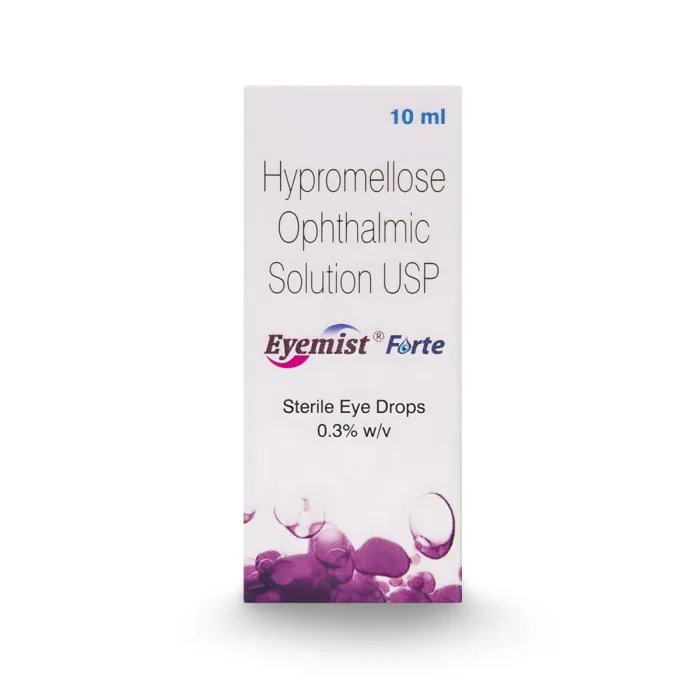Neurotrophic Keratitis is a rare but significant eye condition that affects the cornea, the clear outer layer of the eye.
Although not as common as other eye conditions, it can lead to severe complications if left untreated.
It is caused by the damage of a vital nerve in the eye, which helps regulate eye health.
This article will explore Neurotrophic Keratitis, its stages, and the various treatment options available to manage this condition.
Neurotrophic Keratitis: A Closer Look
Neurotrophic Keratitis, often abbreviated as NK, arises from damage or dysfunction of the trigeminal nerve.
The trigeminal nerve is responsible for carrying sensory information to the cornea.
This vital nerve helps regulate the health and integrity of the cornea by providing essential nutrients and stimulating protective reflexes, such as blinking and tearing.
The damaged nerve function disrupts the functioning of the cornea, causing Neurotrophic Keratitis.
Save up to 90% on your medicine bills

Eyemist Forte 10 ml

Milflox 0.5% 5 ml

Restasis 0.05% Ophthalmic Emulsion

Pred Forte 10 ml
Neurotrophic Keratitis Stages
Neurotrophic Keratitis is categorized into three stages, each representing a different level of corneal damage and severity.
Understanding these stages is crucial in diagnosing and managing the condition effectively.
Stage 1: Mild Neurotrophic Keratitis
 Source: Alliance_Images_from_Alliance_Images
Source: Alliance_Images_from_Alliance_ImagesPatients may not experience significant symptoms in the early stages, making diagnosis challenging.
However, common symptoms of Keratitis include decreased corneal sensitivity and reduced tear production.
Because of this reduced sensitivity, individuals may not blink as frequently, leading to eye pain and red eyes.
Stage 2: Moderate Neurotrophic Keratitis
As the condition progresses, the second stage of Neurotrophic Keratitis becomes more noticeable.
Patients may experience symptoms like persistent dryness, a gritty eye sensation, and increased sensitivity to light.
Stage 3: Severe Neurotrophic Keratitis
In this advanced stage of Neurotrophic Keratitis, patients face substantial challenges.
The cornea becomes significantly damaged, leading to persistent pain, blurred vision, and potential vision loss.
Neurotrophic Keratitis Treatment
Treatment for Neurotrophic Keratitis aims to alleviate symptoms, promote corneal healing, and prevent further complications.
The treatment approach depends on the condition’s stage and underlying Keratitis causes.
Stage 1 treatment options
 Source: tirc83_from_Getty_Images
Source: tirc83_from_Getty_ImagesThere are various treatment options available for stage 1 treatment of Neurotrophic Keratitis, such as artificial tears, punctual plugs, and supplements.
Artificial tears: Patients with mild Neurotrophic Keratitis can benefit from using artificial tears to maintain corneal moisture and reduce dryness.
Punctal plugs: In some cases, doctors may recommend punctal plugs, which block the tear ducts to prevent excessive tear drainage and help maintain a more stable tear film.
Nutritional supplements: Omega-3 fatty acids and vitamin A supplements may be prescribed to improve corneal health.
Stage 2 treatment options
There are various treatment options available for stage 2 treatment of Neurotrophic Keratitis, such as topical medication and amniotic membrane transplantation.
Topical medications: In moderate Neurotrophic Keratitis, Keratitis eye drops, ointments, or gels containing growth factors or neurotrophic agents can stimulate corneal healing.
Amniotic membrane transplantation: This surgical procedure involves placing a piece of amniotic membrane on the cornea to support healing and reduce inflammation.
Stage 3 treatment option
There are various treatment options available for stage 3 treatment of Neurotrophic Keratitis, such as autologous serum eye drops and tarsorrhaphy.
Autologous serum eye drops: In severe cases, Autologous serum eye drops may be prescribed to provide essential growth factors and nutrients to the cornea.
Tarsorrhaphy: Tarsorrhaphy is a surgical procedure in which the eyelids are particularly sewn together to protect the cornea and reduce environmental exposure.
This surgery might be temporary or permanent, depending on the severity of the condition.
To learn more about other treatment options for Keratitis, read Keratitis Treatment.
Conclusion
Neurotrophic Keratitis is a challenging condition that affects the cornea and can lead to severe complications if not managed properly.
The stages of Neurotrophic Keratitis help doctors analyze the severity of the condition and tailor treatment accordingly.
From artificial tears to corneal transplants, a range of treatment options is available to address the different stages of this condition.
With early diagnosis and appropriate treatment, individuals with Neurotrophic Keratitis can manage their condition effectively and prevent further corneal damage.

Frequently Asked Questions
Who is at higher risk of developing Neurotrophic Keratitis?
People with conditions like Diabetes, Herpes Keratitis or those who have undergone eye surgery are at a higher risk of developing Neurotrophic Keratitis.
Can Neurotrophic Keratitis impact both eyes?
Yes, it can affect one or both eyes, and the severity of the condition may differ between both eyes.
Is Neurotrophic Keratitis curable?
Yes, Neurotrophic Keratitis is a chronic condition, but with appropriate treatment, its progression can be managed, and symptoms alleviated. Many treatment options, such as artificial tears, punctual plugs, and tarsorrhaphy, are available for the treatment of Neurotrophic Keratitis
Is surgery always required for Neurotrophic Keratitis treatment?
No, surgery is not required till the advanced stages of Neurotrophic Keratitis. Earlier stages are often managed with eye drops and medications such as artificial tears, punctual plugs, and supplements.
What are the symptoms of Neurotrophic Keratitis?
Common symptoms of Neurotrophic Keratitis include eye dryness, redness, blurred vision, and discomfort. In advanced stages, it may lead to corneal ulcers and vision impairment
Cheap Medicine Shop only refers to credible, authoritative sources for our content. If you’re curious about how we ensure the integrity of our content, we encourage you to read our Content Information Policy.













